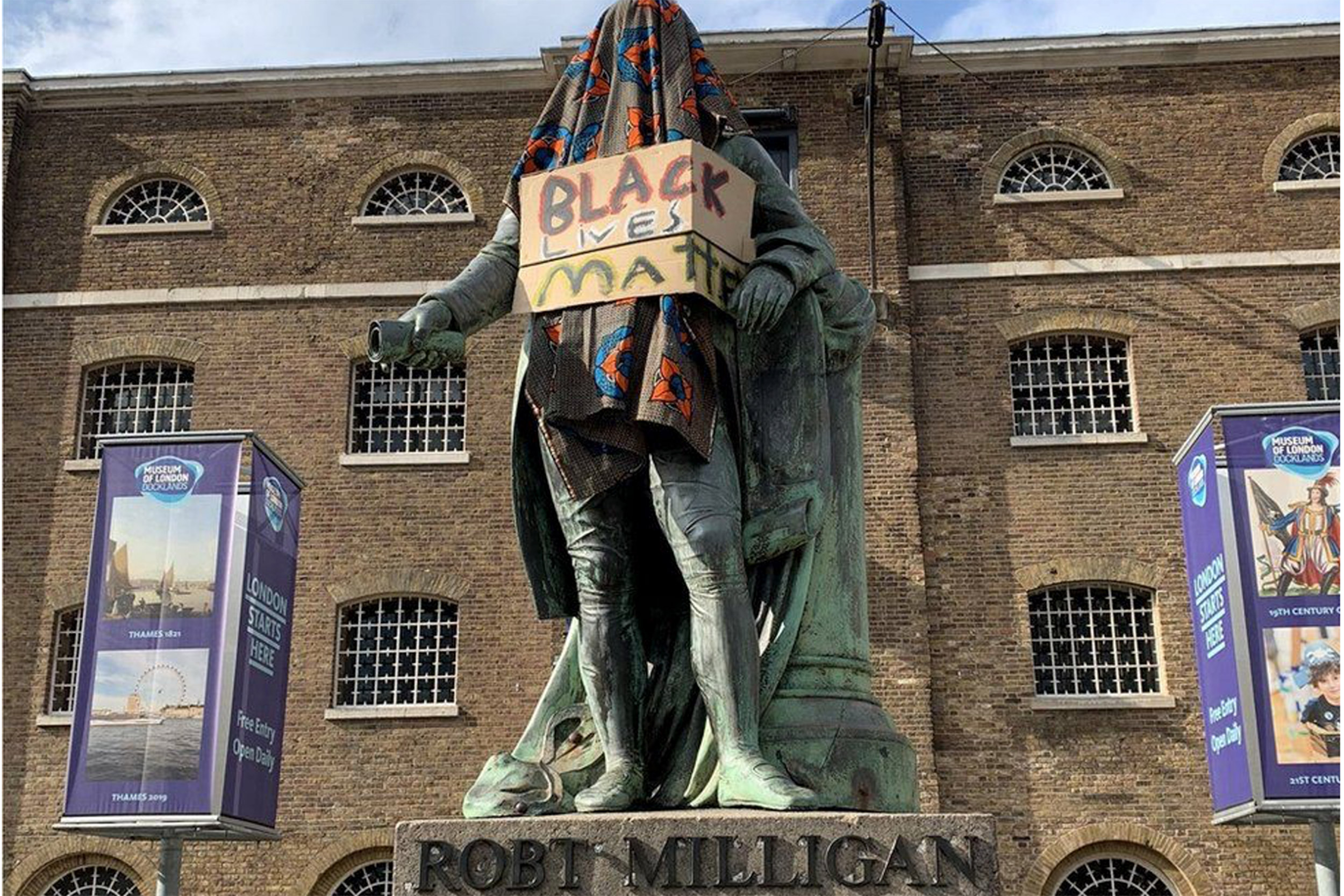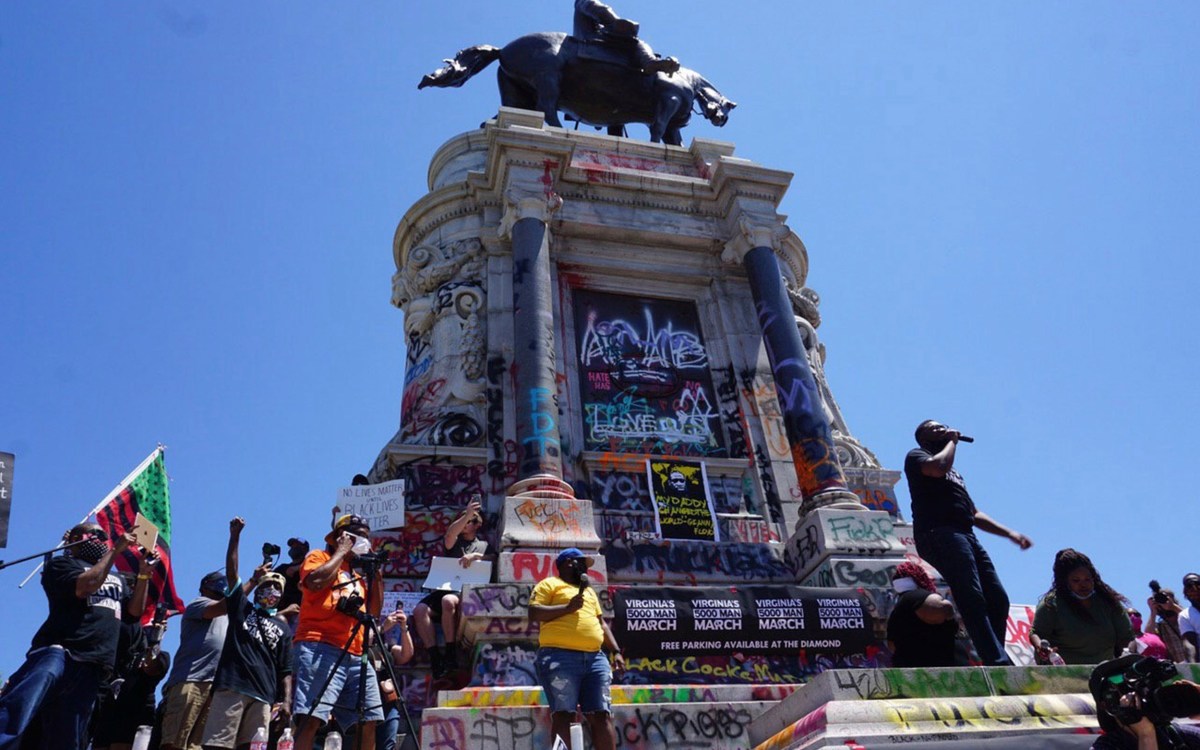
The Robert Milligan statue in the West India Docks of London.
Images courtesy of CES
What to keep
Reassessing public art in Europe in light of increased racial awareness
Who owns the public space, and who should be represented within it — and how? The questions have relevance within and beyond America’s borders, and they are at the forefront of movements to remove or rebrand monuments and public art that commemorate historical figures associated with slavery, colonialism, and racism.
On Wednesday, Ana Lucia Araujo, professor of history at Howard University, and Mame-Fatou Niang, associate professor of French and francophone studies at Carnegie Mellon University, discussed both the history and the way forward during “Race and Remembrance in Contemporary Europe,” presented by the Minda de Gunzburg Center for European Studies (CES).
Introducing the Zoom discussion as a reassessment of “monuments and memorialization in Europe,” Mary D. Lewis, Robert Walton Goelet Professor of French History and CES resident faculty, described ongoing and international turbulence as activists seek to present a more complete picture of their countries’ history. “Silencing is an active process,” said Lewis, referencing the Haitian anthropologist Michel-Rolph Trouillot.
The past summer’s Black Lives Matter demonstrations in the U.S. inspired activists around the world, the scholars said. In the United Kingdom, protesters tore down a statue of the slave trader Edward Colston and tossed it in Bristol harbor. In the U.S., activists have taken down similar monuments or transformed them, such as by projecting images of Rep. John Lewis, Martin Luther King Jr., Harriet Tubman, and W.E.B. Du Bois on a statue of Robert E. Lee in Richmond, Va. Around the world, activists and protesters are pushing for reassessment and removal of such problematic pieces.
Removing public art that has outlived its political relevance is nothing new, Araujo said. During the American Revolution, statues of England’s king were torn down, and monuments in former Eastern Bloc countries were toppled as the Communist regime crumbled. Statues of people who ruled or grew rich by exploiting Black lives, however, are harder to fell, and their continued survival supports and perpetuates bias and national myths. Commemorating such people in public spaces engages and encourages white supremacists, said Araujo, whose most recent book is “Slavery in the Age of Memory Engaging the Past.” She said artwork celebrating slavers ties in with “the ways white supremacy denies racism.”

Statues of prominent slave traders or slave holders did not begin to acknowledge the roots of their riches or power until the 1990s, Araujo said. Public art that decried slavery tended to focus on white abolitionists, rather than enslaved individuals and their descendants. “The public memory of slavery remains a contested battlefield,” she said.
In France, said Niang, the battle is particularly heated, as discussions of slavery and colonialism are often taken as an attack on the country. Slavery, for example, is taught as a foreign evil, focusing on countries like Brazil and the U.S., while the domestic focus is kept on abolition. As for its monuments, President Emmanuel Macron has said that France will “erase no trace or names of its history, it will forget none of its works, it will tear down none of its statues.”
Following the recent beheading of teacher Samuel Paty by a teenage Islamist extremist, this stance has hardened. The murder was seen as a direct assault on France and Republican values such as laïcité (secularism) and freedom of speech. Since Paty’s death, questioning the Republic has risked being interpreted as condoning terrorism.
Niang has herself been threatened because of her anti-racist work. The co-director of “Mariannes Noires,” a 2017 documentary about the mosaic identities of Afro-French women, Niang spearheaded a petition to remove a Hervé Di Rosa fresco from the French National Assembly. Created to commemorate the bicentennial of France’s abolition of slavery in 1794, the work uses racist stereotypes to depict enslaved Africans.
Niang said that although the descendants of those who were enslaved are French citizens and have been for generations, anti-racist efforts like her petition are viewed as unpatriotic and complicated by a centralized education system resistant to change. “To touch on this subject is to touch the Republic,” she said.
Araujo and Niang agreed the way forward starts by adding context. “The nation is what we collectively forget versus what we remember,” Niang said. “We have to talk about Haiti. We have to talk about Toussaint. We have to talk about the colonies.”
This is particularly important in areas associated with slavery. In Bristol, Araujo said, the Georgian House Museum now showcases the role of the enslaved Pero Jones alongside that of the house’s owner, John Pinney; nearby, Pero’s Bridge also memorializes the enslaved man. Liverpool, a major port for the Atlantic slave trade, now has an International Slavery Museum. Considered an “activist museum,” it has Black curators and hosts commemoration events. “It’s not very big,” Araujo said. “But it’s an important step, arising from the demands of activists.”
However, the battle over existing monuments continues. Calling it “a fight for symbolic reparations,” Araujo ties it to ongoing struggles against racism and for inclusion. “It’s all about not what’s happening in the past but what’s happening in the present, a battle to see who is going to occupy this public space.”
“From Bristol to D.C., this is not a ‘cancel culture’ nor a vengeful request,” said Niang. “What we need, at least in France, is to try to get as many people as possible around the table. It is hard, but we need to have a conversation.”






